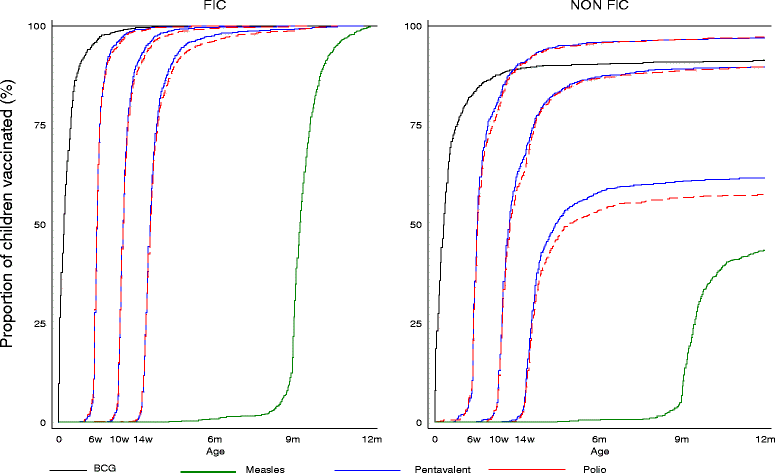Fully immunized child: coverage, timing and sequencing of routine immunization in an urban poor settlement in Nairobi, Kenya
- PMID: 27433132
- PMCID: PMC4940963
- DOI: 10.1186/s41182-016-0013-x
Fully immunized child: coverage, timing and sequencing of routine immunization in an urban poor settlement in Nairobi, Kenya
Abstract
Background: More efforts have been put in place to increase full immunization coverage rates in the last decade. Little is known about the levels and consequences of delaying or vaccinating children in different schedules. Vaccine effectiveness depends on the timing of its administration, and it is not optimal if given early, delayed or not given as recommended. Evidence of non-specific effects of vaccines is well documented and could be linked to timing and sequencing of immunization. This paper documents the levels of coverage, timing and sequencing of routine childhood vaccines.
Methods: The study was conducted between 2007 and 2014 in two informal urban settlements in Nairobi. A total of 3856 children, aged 12-23 months and having a vaccination card seen were included in analysis. Vaccination dates recorded from the cards seen were used to define full immunization coverage, timeliness and sequencing. Proportions, medians and Kaplan-Meier curves were used to assess and describe the levels of full immunization coverage, vaccination delays and sequencing.
Results: The findings indicate that 67 % of the children were fully immunized by 12 months of age. Missing measles and third doses of polio and pentavalent vaccine were the main reason for not being fully immunized. Delays were highest for third doses of polio and pentavalent and measles. About 22 % of fully immunized children had vaccines in an out-of-sequence manner with 18 % not receiving pentavalent together with polio vaccine as recommended.
Conclusions: Results show higher levels of missed opportunities and low coverage of routine childhood vaccinations given at later ages. New strategies are needed to enable health care providers and parents/guardians to work together to increase the levels of completion of all required vaccinations. In particular, more focus is needed on vaccines given in multiple doses (polio, pentavalent and pneumococcal conjugate vaccines).
Keywords: Coverage; Fully immunized child; Vaccination delay; Vaccination sequence.
Figures
Similar articles
-
New Vaccine Introduction and Childhood Vaccination Timeliness in Two Urban, Informal Settlements in Nairobi, Kenya.Am J Trop Med Hyg. 2021 May 17;105(1):245-253. doi: 10.4269/ajtmh.21-0006. Am J Trop Med Hyg. 2021. PMID: 33999852 Free PMC article.
-
Vaccination coverage and immunization timeliness among children aged 12-23 months in Senegal: a Kaplan-Meier and Cox regression analysis approach.Pan Afr Med J. 2017 Jun 21;27(Suppl 3):8. doi: 10.11604/pamj.supp.2017.27.3.11534. eCollection 2017. Pan Afr Med J. 2017. PMID: 29296143 Free PMC article.
-
Effect of vaccine reminder and tracker bracelets on routine childhood immunization coverage and timeliness in urban Pakistan: protocol for a randomized controlled trial.BMC Public Health. 2019 Oct 30;19(1):1421. doi: 10.1186/s12889-019-7667-3. BMC Public Health. 2019. PMID: 31666039 Free PMC article.
-
Effect of vaccine reminder and tracker bracelets on routine childhood immunization coverage and timeliness in urban Pakistan (2017-18): a randomized controlled trial.BMC Public Health. 2020 Jul 11;20(1):1086. doi: 10.1186/s12889-020-09088-4. BMC Public Health. 2020. PMID: 32652969 Free PMC article. Clinical Trial.
-
The impact of COVID-19 and catch-up strategies on routine childhood vaccine coverage trends in Latin America: A systematic literature review and database analysis.Hum Vaccin Immunother. 2022 Nov 30;18(6):2102353. doi: 10.1080/21645515.2022.2102353. Epub 2022 Sep 9. Hum Vaccin Immunother. 2022. PMID: 36084255 Free PMC article.
Cited by
-
Effect of Mobile Phone Text Message Reminders on the Completion and Timely Receipt of Routine Childhood Vaccinations: Superiority Randomized Controlled Trial in Northwest Ethiopia.JMIR Mhealth Uhealth. 2021 Jun 15;9(6):e27603. doi: 10.2196/27603. JMIR Mhealth Uhealth. 2021. PMID: 34128813 Free PMC article. Clinical Trial.
-
Association between access to a health facility and continuum of vaccination behaviors among Nigerian children.Hum Vaccin Immunother. 2020 May 3;16(5):1215-1220. doi: 10.1080/21645515.2019.1678360. Epub 2019 Nov 5. Hum Vaccin Immunother. 2020. PMID: 31634047 Free PMC article.
-
Do inequalities exist in the disadvantaged populations? Levels and trends of full and on-time vaccination coverage in two Nairobi urban informal settlements.Glob Epidemiol. 2020 Nov;2:100044. doi: 10.1016/j.gloepi.2020.100044. Glob Epidemiol. 2020. PMID: 33363280 Free PMC article.
-
Adverse Events Following Immunizations in Infants Under 1 Year of Age in Lorestan Province, Western Iran.J Prev Med Public Health. 2023 Mar;56(2):172-179. doi: 10.3961/jpmph.22.540. Epub 2023 Mar 14. J Prev Med Public Health. 2023. PMID: 37055359 Free PMC article.
-
What predicts complete immunisation among 18-month to 24-month-old children in the urban slum area of Hlaingthayar Township, Yangon Region, Myanmar? A cross-sectional study.BMJ Public Health. 2024 Dec 10;2(2):e001311. doi: 10.1136/bmjph-2024-001311. eCollection 2024 Dec. BMJ Public Health. 2024. PMID: 40018555 Free PMC article.
References
-
- World Health Organization . United Nations Children’s Fund (UNICEF) 2008.
-
- Nations United. Sustainable Development Goals. 2015.
-
- World Health Organization . Global immunization data. 2014.
-
- Global Polio Eradication Initiative . Polio eradication and endgame strategic plan (2013–2018) Geneva: World Health Organization, Global Polio Eradication Initiative; 2013. p. 2013.
-
- World Health Organization. WHO Recommendations for Routine Immunization. 2013.
Grants and funding
LinkOut - more resources
Full Text Sources
Other Literature Sources
Medical


